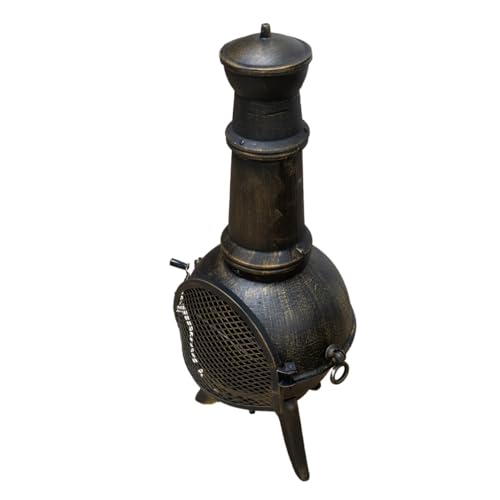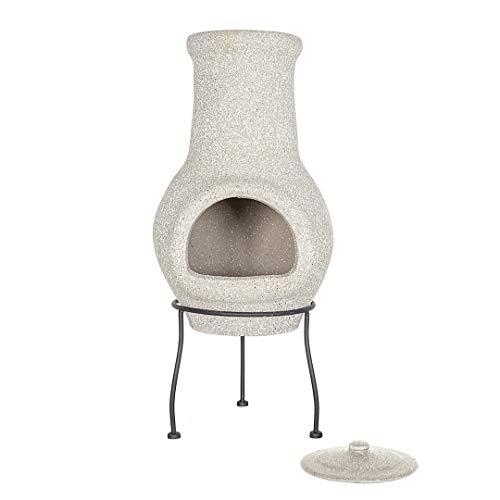9 Things Your Parents Teach You About Chiminea Terracotta
페이지 정보
작성자 Ina 댓글 0건 조회 3회 작성일 24-11-24 18:07본문
 A chiminea terracotta - Highly recommended Internet site, Adds Warmth and Ambiance to Your Backyard Patio
A chiminea terracotta - Highly recommended Internet site, Adds Warmth and Ambiance to Your Backyard PatioChiminesas can add warmth and ambience to your backyard. The chimney directing the smoke upwards, thus preventing sparks and flames from damaging nearby plants or burning the deck or your home.
 Chimineas made of clay need to be coated with a seasoned (broken into) slowly. The initial fires should be small and slow-burning. Sealing your chimineas, especially if you live in a wet climate, is advised.
Chimineas made of clay need to be coated with a seasoned (broken into) slowly. The initial fires should be small and slow-burning. Sealing your chimineas, especially if you live in a wet climate, is advised.Material
A chiminea is an excellent way to add warmth and personality to your backyard patio. Its traditional pot-belly design is ideal for entertaining, but modern designs now suit a wide range of decor styles. While clay is the most commonly used material, chimineas are available in cast iron and aluminum. Each material type has its own benefits. While clay is easy-to-maintain, metal is more robust. It can also endure higher temperatures.
When selecting a chiminea, think about its size, shape and fuel type. The chiminea's size should be able to accommodate the amount of wood you intend to utilize to ensure a steady flame. The larger models are more suitable for large gatherings, while smaller models work better in smaller spaces. A chimney directs smoke upward and protects the surrounding area from rain and preventing it from being blown around by strong winds.
The design of the chiminea is unique from other outdoor firepits. The bowl-shaped base holds the flames and shields them from rain, wind and other debris. The chimney adds a stylish design and allows you to control the size of the flames.
Clay chimineas can be shaped by hand, and then fired at high temperatures. They are often coated with Ceramic chimineas glaze to make them more attractive and resistant against weather damage. Some are decorated with Mexican-inspired patterns. These chimineas are usually sold at garden stores and home improvement centers.
Before lighting a chiminea you must cover its interior with coarse-grained gravel or sand. Sand helps to reduce smoke and also prevents the clay from cracking during firing. Once you've covered the base, you can place small pieces of kindling in the center. Add a natural lighter, like this one from Amazon, to make lighting easier.
Use a long-handled spatula or fork to turn the hot embers when you're ready. Cooking food should not be done in direct flames since it could cause burning and darken the food beyond recognition. Begin with a small flame and build it up slowly. Then, transfer the cooking pan to the top rated chiminea of the smoke stack.
Design
A chiminea is a type of fire pit that appears like a large-bottomed stove with a mouth for the fire and a long, narrow chimney for smoke. The chimney also protects the fire from the rain and wind and can also extinguish a more open fire pit. Chimineas have been used for over four hundred years to gather, cooking and heating homes. They were originally made of clay but now they are made in both contemporary and traditional styles, and in cast iron or Terracotta.
While modern chimineas often eschew the curvatures of traditional models, they still retain the distinctive chimney design. You can find them in a wide range of shapes and sizes. They range from 12 to 16 inches diameter at the base and 25 to 30 inches in height (including the stand). The chimney usually rises about 6 feet.
The height of a chiminea is crucial since it helps to direct smoke upwards, which will stop it from blowing into the people or objects in your yard or house. It also lets you make use of aromatic woods that smell good when they burn, which adds to the pleasure of sitting around a fireplace.
When you're choosing a chiminea, look for one that's made of durable material that can withstand extreme temperatures. Avoid models with ornaments or features that may crack or break when heated. If you choose to purchase a clay chiminea or terracotta one, you must to get it seasoned by burning small quantities of wood for 3 to 4 hours. This will allow the clay to cure. When not in use, the chiminea needs to be covered with a lid in order to prevent water from spilling onto the flames. This could cause it to burn.
Cast iron chimineas can withstand higher temperatures and more harsh treatment because they are heavier and more durable than clay models. They also have more versatility, as they can burn coal or briquettes in addition to wood. If you're looking for a classic design, choose an chiminea made of clay.
Whatever material you select, put your chiminea inside a fire-proof area away from your home as well as any outside furniture or plants. The chiminea must be at least 10 feet from other structures, like a shed or fence. Create a hearth in your patio using pavers to create an area to put your chiminea, making it easier to control the flame.
Installation
Chimineas add a completely new dimension to any outdoor space, and is the centerpiece for gatherings with the family. It is essential to understand the requirements for maintaining a chiminea grill before purchasing one. Traditional clay chimineas sale tend be more fragile than chimineas made of cast iron, although both can withstand the elements, but the different designs and materials require a different approach to care.
The base of the chiminea before. The base of the chiminea modern must be covered with gravel or sand to prevent it from coming into direct contact with fire. This will cut down on smoke and prevent the chiminea from breaking.
It is important to ensure that the chiminea has been installed in a secure and stable location. Avoid placing it on decks or other surfaces that are flammable. If you must place it on a flammable area you can use a metal grates to raise the wood. This will protect the chiminea from heat and sparks of the fire.
It is crucial to season the chiminea prior lighting it for the first time. This can be accomplished by lighting a few small fires. This will prevent it from cracking if you burn a lot of wood.
After each fire, clean the chiminea thoroughly by brushing it with a wire bristle brush or dry cloth. It is also important to get rid of any creosote or ash inside the chiminea. If these chemicals aren't removed, they can affect the quality of subsequent fires you set within it.
The chiminea should be covered with a protective cover when it is not in use. This will stop the clay from getting too wet which causes it to shrink and crack. Chimineas are susceptible to this type of damage if left continuously exposed to snow and rain.
The best way to protect the chiminea is to have it covered, even during summer. It is also a good idea to have a different fuel source for the fire such as wood or propane tanks. Additionally, it is a good idea to keep a fire extinguisher nearby to stop any sudden fires.
Maintenance
Despite the different materials that chimineas are fabricated from They all require regular maintenance to ensure that they last as long as possible. This includes maintaining the structure in good condition, applying protective coatings, and storing it properly in the off-season to protect against extreme weather conditions. By taking these precautions and adhering to basic usage guidelines will extend the life of your chiminea and decrease potential safety hazards.
Chimineas, which is made from clay, could crack if exposed to sudden temperature changes. This is why it's important to store your terra cotta in a dry and secure location during the off-season, preferring the cover to guard against frost and rain. It is also recommended to regularly apply an adhesive to your clay fireplace to shield it from moisture and temperature changes.
To avoid damaging the clay surface, make use of a non-abrasive item and a soft cloth or brush to clean the Chiminea. A hose or bucket of water should be used to rinse off the surface after scrubbing it and it's crucial to let the chiminea dry completely before reusing it. This will prevent the growth of mildew and mold and will keep it looking fresh.
If you have a cracked area on your chiminea, it is important to clamp the pieces together. Then, you can apply outdoor oven cement over the crack. It can be bought at the majority of hardware stores. It is applied with a spatula or pointing trowel. The cement should be allowed to dry thoroughly before you can start a test fire in the chiminea.
After the cement has dried, put medium-coarse sandpaper on the damaged area to prepare it for painting. Then, you can paint it with a mixture of more than or less any emulsion paint for masonry or household use in a shade that matches the rest of your chiminea. If the chiminea has any corrosion or rust take it off by sanding the affected areas and then washing them with water to rid them of any dirt or dust particles.
- 이전글미프진효과 | 카톡 mfg66 | 정품미프진효과 (카톡 mfg66) 24.11.24
- 다음글14 Smart Ways To Spend Left-Over Best SEO Agency Uk Budget 24.11.24
댓글목록
등록된 댓글이 없습니다.



